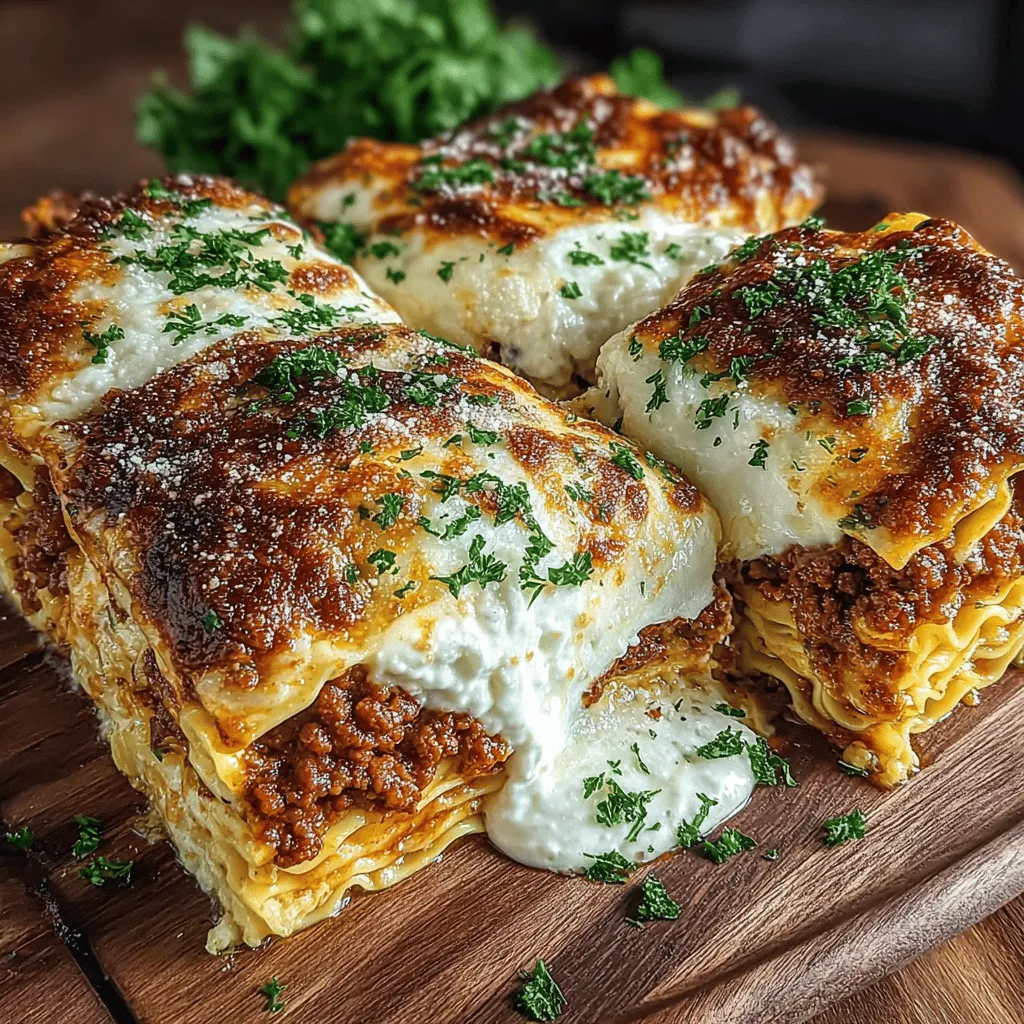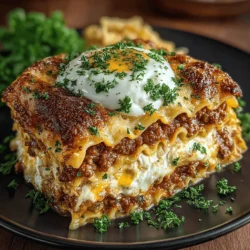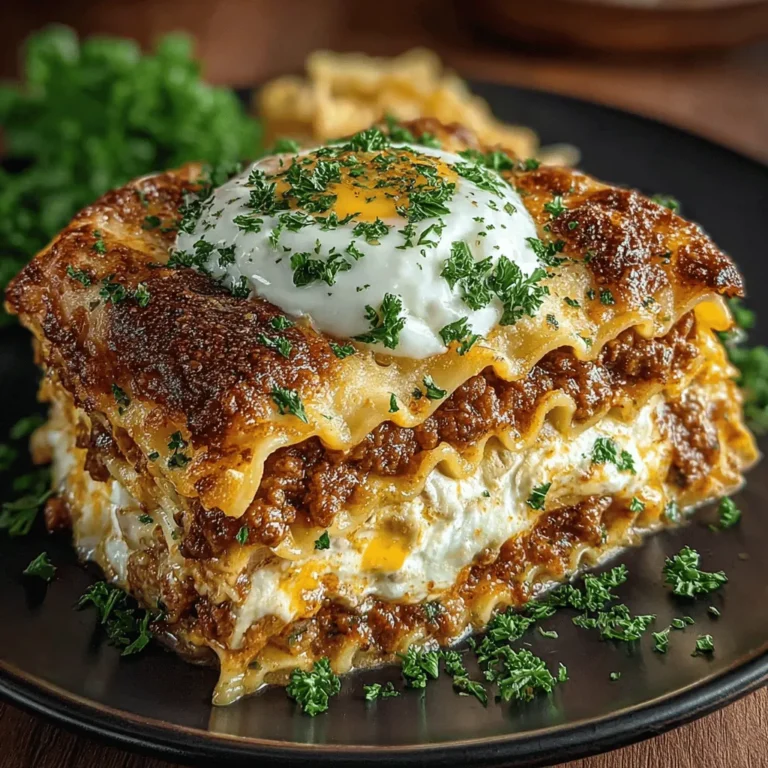Introduction: Discover the Comfort of Classic Homemade Meat Lasagna
Lasagna is more than just a dish; it’s a culinary embrace that evokes fond memories of family gatherings and hearty meals shared around the dinner table. This classic homemade meat lasagna recipe is a celebration of rich flavors and comforting textures, featuring layers of savory meat sauce, creamy ricotta, and gooey mozzarella all nestled between sheets of tender pasta. The beauty of lasagna lies not only in its taste but also in the warmth and nostalgia it brings, making it a beloved favorite in countless households.
The process of crafting a homemade lasagna is an art form that allows for creativity while adhering to traditional recipes. As we embark on this culinary journey, we will explore the essential ingredients and provide step-by-step instructions to help you create a flawless lasagna that will impress your family and friends. From understanding the history of this iconic dish to perfecting each layer, this article is designed to be your comprehensive guide to making classic meat lasagna.
The Rich History of Lasagna: A Culinary Tradition
To fully appreciate this beloved dish, it’s important to understand its origins. Lasagna’s lineage can be traced back to Ancient Greece and Rome, where layers of pasta were first introduced. The Greeks had a dish called Laganon, which was made of layers of pasta cut into strips and baked with sauce—a precursor to what we now know as lasagna. Over centuries, this ancient recipe evolved, particularly in Italy, where it became a staple of regional cuisine.
In Italy, lasagna varies dramatically from region to region. For instance, the Neapolitan version often features a rich meat sauce made with pork and beef, while the Bolognese variation is known for its creamy béchamel sauce. The beauty of lasagna lies in its adaptability; it can be made vegetarian, seafood-based, or as a hearty meat dish, allowing it to fit into diverse culinary traditions. As it spread across the world, lasagna transformed into a comfort food that resonates with many cultures, making it a true global favorite.
Ingredients: A Symphony of Flavors
Creating a memorable lasagna starts with quality ingredients. Each component contributes to the dish’s overall flavor and texture, making it essential to select the best possible options. Here’s a breakdown of the key ingredients that will come together to create your layered masterpiece:
– Lasagna Noodles: The backbone of the dish, lasagna noodles provide the structure and absorb the flavors of the sauce. You can opt for traditional dried lasagna noodles or fresh pasta for a more delicate texture.
– Ground Beef and Italian Sausage: These proteins form the heart of the meat sauce, adding richness and depth. Using a combination of beef and sausage enhances the flavor profile, creating a savory base for your lasagna.
– Onion and Garlic: Aromatics like onion and garlic are crucial for building a flavorful sauce. Sautéing these ingredients releases their natural sweetness, which complements the meat beautifully.
– Crushed Tomatoes and Tomato Paste: These are the foundation of the sauce, providing moisture and a touch of sweetness. Crushed tomatoes lend a chunky texture, while tomato paste intensifies the flavor.
– Herbs: Fresh basil and oregano are classic additions that brighten the dish. Their fragrant aroma elevates the overall taste, making each bite a delightful experience.
– Ricotta Cheese: This creamy cheese adds a layer of smoothness to the lasagna. Mixed with an egg for binding, it creates a rich filling that balances the savory meat sauce.
– Egg: The egg not only binds the ricotta cheese mixture but also adds a slight creaminess that contributes to the overall texture.
– Mozzarella and Parmesan Cheese: These cheeses are essential for achieving that gooey, melty finish that everyone loves. Mozzarella provides stretchiness, while Parmesan adds a nutty flavor.
– Garnish: Fresh parsley is a simple yet effective garnish that adds a pop of color and a hint of freshness to the finished dish.
Step-by-Step Instructions: Crafting Your Lasagna Masterpiece
Now that we’ve set the stage with a rich history and a detailed look at the ingredients, it’s time to dive into the preparation of your classic meat lasagna. Follow these simple steps to ensure your dish turns out perfectly every time.
Step 1: Prepare the Meat Sauce
Begin by heating a large skillet over medium heat. Add a drizzle of olive oil, then sauté finely chopped onions until they become translucent. Next, add minced garlic and cook for an additional minute, stirring to prevent burning.
Once the aromatics are ready, add the ground beef and Italian sausage to the skillet. Use a wooden spoon to break the meat apart as it cooks, allowing it to brown evenly. Season with salt, pepper, and a sprinkle of dried oregano. Cook until the meat is no longer pink, then drain any excess fat.
Incorporate crushed tomatoes and a tablespoon of tomato paste into the skillet, stirring to combine. Let the sauce simmer for about 20-30 minutes on low heat, allowing the flavors to meld together. If desired, add a splash of red wine for extra depth.
Step 2: Prepare the Ricotta Mixture
While the meat sauce is simmering, it’s time to prepare the creamy ricotta filling. In a medium bowl, combine the ricotta cheese, an egg, a pinch of salt, and a handful of freshly chopped basil. Mix until smooth and well combined. This filling will provide a rich, creamy layer in your lasagna that perfectly complements the savory meat sauce.
Step 3: Cook the Lasagna Noodles
If you’re using dried lasagna noodles, cook them according to the package instructions until al dente. This typically involves boiling them in salted water for about 8-10 minutes. If you’re using fresh pasta, you can skip this step, as fresh noodles will cook while baking in the oven.
Once cooked, drain the noodles and lay them flat on a clean kitchen towel to prevent them from sticking together.
Step 4: Assemble the Lasagna
Now comes the fun part—layering your lasagna! Preheat your oven to 375°F (190°C). In a 9×13-inch baking dish, spread a thin layer of meat sauce on the bottom to prevent the noodles from sticking.
Begin layering by placing sheets of lasagna noodles over the sauce. Next, add a generous layer of the ricotta mixture, followed by a layer of meat sauce. Sprinkle a handful of mozzarella and Parmesan cheese over the meat sauce. Repeat the layering process until all ingredients are used, finishing with a layer of noodles topped with meat sauce and a generous amount of mozzarella and Parmesan.
Step 5: Bake the Lasagna
Cover the baking dish with aluminum foil to prevent the cheese from browning too quickly. Bake in the preheated oven for 25 minutes. After 25 minutes, remove the foil and continue baking for an additional 15-20 minutes, or until the cheese is bubbly and golden brown.
Step 6: Let it Rest
Once baked, remove the lasagna from the oven and let it rest for at least 15-20 minutes before slicing. This resting period allows the layers to set, making it easier to serve.
As you prepare to dive into your warm, cheesy creation, take a moment to appreciate the love and effort that went into crafting this layered comfort food. With its rich history, flavorful ingredients, and simple assembly, classic homemade meat lasagna is sure to become a cherished recipe in your kitchen for years to come.

Preheat the Oven
Before diving into the delicious assembly of lasagna, preheating your oven is essential. Setting your oven to 375°F (190°C) ensures that the lasagna cooks evenly and thoroughly. A properly preheated oven helps achieve the perfect golden-brown top layer of cheese while ensuring that the pasta and meat sauce are fully heated through. This step is often overlooked but is crucial for achieving that ideal texture and flavor combination that makes lasagna so comforting.
Cook the Noodles
Cooking the lasagna noodles requires a bit of attention to achieve the perfect texture. Start by boiling a large pot of salted water. Add the noodles, and cook them until they are al dente, which typically means they should be firm to the bite. This is important because the noodles will continue to soften as they bake in the oven. After cooking, drain the noodles and lay them flat on a clean kitchen towel or parchment paper to prevent them from sticking together. If you’re using no-boil noodles, you can skip this step, but ensure you have enough moisture in your sauce to cook them properly during baking.
Prepare the Meat Sauce
The meat sauce is the heart of your lasagna, and proper preparation is key to building depth of flavor. In a large skillet or saucepan, heat a tablespoon of olive oil over medium-high heat. Once the oil is hot, add your ground beef (or a mix of beef and pork for added richness) and break it apart with a wooden spoon. Brown the meat thoroughly, allowing it to caramelize slightly. This browning process creates a rich base flavor. Once the meat is cooked through, drain excess fat if necessary, then add finely chopped onions and minced garlic, sautéing until fragrant and the onions are translucent.
Add Tomatoes and Herbs
After the meat and aromatics are nicely sautéed, it’s time to build your sauce. Pour in crushed tomatoes and tomato paste, stirring well to combine. Season with salt, pepper, and a pinch of sugar to balance the acidity of the tomatoes. Fresh herbs elevate the flavor profile, so consider adding a handful of chopped fresh basil and oregano, or if using dried herbs, about a teaspoon of each. Allow the sauce to simmer on low heat for at least 20-30 minutes. This simmering time is crucial for melding the flavors and developing that rich, comforting taste that makes lasagna so beloved.
Prepare the Cheese Mixture
While the sauce simmers, it’s time to prepare the cheese mixture that will add creaminess and depth to your lasagna. In a medium-sized bowl, combine ricotta cheese, an egg (which helps bind the mixture), and a generous portion of grated Parmesan cheese. Season with salt, pepper, and a sprinkle of nutmeg, which adds a subtle warmth and enhances the overall flavor. Mix until smooth and creamy, ensuring there are no lumps. This mixture will be layered between the noodles and the meat sauce, providing a delightful contrast in texture.
Layer the Lasagna
Now comes the fun part: assembling your lasagna. Begin by spreading a thin layer of meat sauce on the bottom of a 9×13 inch baking dish to prevent sticking. Then, place a layer of noodles over the sauce, followed by half of the ricotta mixture, and then a layer of the meat sauce. Sprinkle a generous amount of shredded mozzarella cheese over the meat sauce. Repeat this layering process: noodles, ricotta, meat sauce, and mozzarella until all ingredients are used, finishing with a final layer of noodles topped with remaining meat sauce and a generous sprinkle of mozzarella and Parmesan cheese. The layering technique not only enhances the flavor but also provides an appealing presentation.
Bake the Lasagna
Once your lasagna is assembled, cover it with aluminum foil (to prevent sticking, ensure the foil does not touch the cheese). Bake in the preheated oven for 25 minutes. After 25 minutes, remove the foil and bake for an additional 25 minutes, or until the cheese is bubbly and golden brown. The lasagna should be heated through, with the sauce bubbling around the edges. If you want an extra crispy top, you can broil it for a minute or two at the end, but keep a close eye to prevent burning.
Let it Rest
After baking, patience is key. Allow the lasagna to rest for at least 15-20 minutes before slicing. This resting period helps the layers set, making it easier to serve and ensuring that the cheese and sauce don’t run all over the plate. Resting also enhances the flavors, allowing them to meld together beautifully.
Serve
When ready to serve, use a sharp knife or spatula to cut through the layers and plate each slice carefully. Consider garnishing with fresh basil or parsley for a pop of color and freshness. This classic meat lasagna pairs wonderfully with a side salad or garlic bread, making for a complete and satisfying meal.
Perfect Pairings: What to Serve with Lasagna
Lasagna is a hearty dish that can be complemented beautifully by various sides. Classic pairings include:
– Garlic Bread: The buttery, garlicky flavors of garlic bread make it a perfect companion to the rich and cheesy lasagna. The crunchy texture contrasts nicely with the soft layers of the lasagna.
– Side Salad: A fresh green salad with a light vinaigrette can provide a refreshing balance to the richness of the lasagna. Consider using mixed greens, cherry tomatoes, and a simple balsamic dressing for a bright complement.
– Roasted Vegetables: Roasted seasonal vegetables, such as zucchini, bell peppers, or asparagus, offer a healthy and colorful side that enhances the overall meal.
– Wine Pairing: If you enjoy wine, a medium-bodied red like Chianti or Sangiovese pairs beautifully with meat lasagna, enhancing the savory flavors of the dish.
Common Mistakes to Avoid When Making Lasagna
Even seasoned cooks can encounter challenges when making lasagna. Here are some common pitfalls and solutions:
– Overcooking Noodles: Noodles should be cooked al dente. If they are overcooked, they will become mushy during baking. Always err on the side of slightly undercooking them, as they will soften further in the oven.
– Under-Seasoning the Sauce: A bland sauce can make the entire dish lackluster. Don’t hesitate to taste and adjust seasoning as you cook, allowing the flavors to develop fully.
– Improper Layering Techniques: Skipping layers or not using enough sauce can result in a dry lasagna. Ensure each layer is adequately coated with sauce and cheese for a moist and flavorful outcome.
– Not Allowing to Rest: Serving immediately can lead to a messy presentation. Always let your lasagna rest to allow the flavors to meld and the layers to set.
Variations on the Classic Lasagna Recipe
Lasagna is incredibly versatile, allowing for numerous variations to cater to different tastes and dietary preferences:
– Vegetarian Lasagna: Substitute the meat with layers of roasted vegetables, spinach, or mushrooms. You can also add a layer of pesto for a fresh twist.
– Seafood Lasagna: For a coastal twist, layer with shrimp, scallops, and a creamy white sauce instead of the traditional meat sauce.
– Gluten-Free Lasagna: Use gluten-free lasagna noodles or zucchini slices for a lighter option while still enjoying the same delicious flavors.
– Cheesy Lasagna: For cheese lovers, consider adding different types of cheese such as Gouda, Fontina, or even blue cheese for a unique flavor profile.
Conclusion: Embrace the Comfort of Homemade Lasagna
Homemade meat lasagna is not just a dish; it is an experience filled with rich flavors and comforting aromas that create lasting memories. By following this detailed guide, you can master the art of lasagna-making and share this beloved recipe with family and friends. Whether you serve it at a family gathering or enjoy a quiet dinner at home, classic homemade meat lasagna is sure to satisfy and delight. The joy of crafting this layered comfort food from scratch is an accomplishment worth celebrating, ensuring that every bite is a taste of love, tradition, and culinary excellence.


